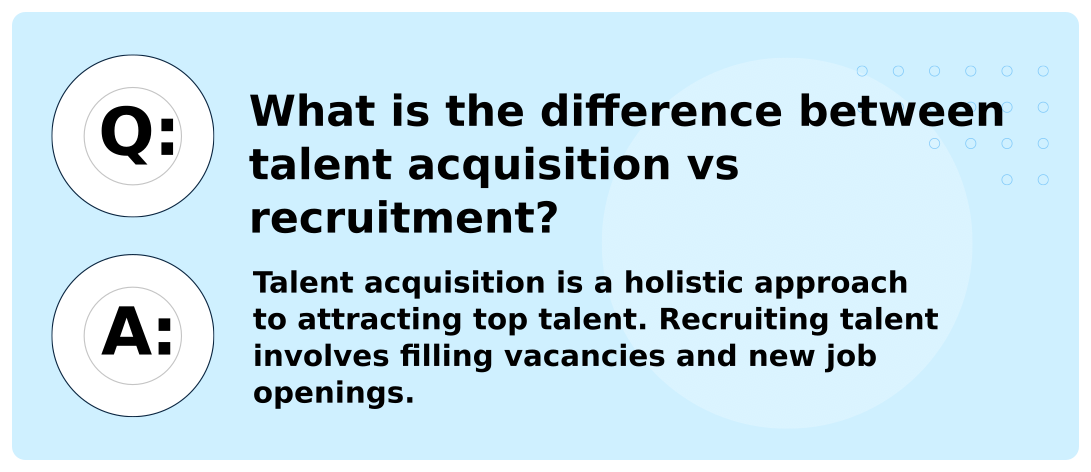The Key Elements of a Modern Talent Acquisition Strategy

The current talent war has left businesses searching for answers. The talent acquisition strategy that followed wasn’t always best practice. Businesses are offering large signing bonuses, inflated salaries, and perks to try and attract new employees. The current talent climate leaves small business owners asking many questions. Are these strategies sustainable? Are they using modern tactics and knowledge? Can small businesses do this like large corporations? Will it pay off? What companies are not having talent acquisition problems?
In short, the current talent acquisition strategies are not necessarily the most sustainable and effective talent acquisition strategies. Top talent typically isn’t persuaded by just a salary increase to join a company and that’s not a sustainable strategy for most businesses. Choosing a job is a multi-dimensional decision and employers must mirror that with factors as to why potential employees should join their company.

Talent Acquisition vs Recruitment
Much of the success and failure of businesses to attract and retain talent lies in the difference between talent acquisition vs recruitment. Talent acquisition is a holistic approach to attracting top talent. It involves intentional employer branding, talent management, company culture, hiring processes, building relationships, and more. It is a proactive approach that has talent in the talent pipeline even when the business is not actively recruiting. An effective talent acquisition strategy is malleable to fit the needs of the business and can change based on metrics. Recruiting talent involves filling vacancies and new job openings. It is reactive and less sustainable. Recruiting talent is pressured by a timeline, which can require costly measures. Businesses that are successfully navigating the current talent landscape use talent acquisition strategies as opposed to a recruitment process.
Talent Acquisition Process
The first step in the talent acquisition process is treating current employees well. Your current employees can be your biggest advocates and recruiters for potential candidates. The second step is building a talent acquisition framework. A framework is developed to think through the process, stakeholders, and goals of a talent acquisition strategy.
5 Key Elements of an Effective Modern Talent Acquisition Strategy for Small Businesses
- Visibility- Potential candidates have to be able to hear about your business. Small businesses need to be their own biggest advocates. Discuss your business to your network, post about it on LinkedIn, and give your employees a reason to be excited about working. Visibility includes, but is not limited to, the searchability of job postings on different job boards or Google. Getting involved in community events, business-related or not, is a great way to increase visibility. Ultimately, it’s difficult to trust and work for a business you’ve never heard of.
- Company Culture- Your company has to have an identifiable culture. Candidates want to know more than the salary and work they will be doing. They want to know the atmosphere. Values are not enough to point to at your company. Your company needs to have examples of culture in action. This builds trust with potential employees.
- Metrics and Feedback- This hallmark of modern talent acquisition is frequently overlooked by small businesses. Data drives better business decisions. Metrics should measure talent acquisition in financial costs, efficiency, and the candidate experience. Most small businesses only measure financial performance.
- Personalization- Qualified candidates will have a better experience when the hiring process from application to onboarding feels personal. Small businesses have an advantage over large companies with their ability to personalize. Typitcally larger businesses are getting dozens of candidates per position which makes personalization difficult. Small businesses can build meaningful relationships with candidates that positively impact the candidate experience. Check-ins, transparency, and personalized feedback are ways to build this into the fabric of your modern talent acquisition strategy.
- Clear Expectations- Modern talent acquisition strategies know potential candidates want clear expectations. The timeline is one example of a way to give these expectations to job seekers. Many businesses, large and small, leave qualified candidates wondering if they will ever hear back from them. Setting a timeline not only improves the experience but also maintains internal consistency. Clear expectations are important with a larger scope as well. The job description should accurately reflect the position requirements and environment. If the description and the actual job do not align, this can lead to problems with talent management and retention.
Step Into the Future of HR
Milestone is dedicated to providing outsourced HR services for the new era of small business. Our strategic HR services help drive modern and people-first small businesses. We know small business executives wear many hats, so our experts ensure the HR function is in good hands. Our team is ready to provide tailored solutions to your talent issues. Contact us today to begin solving your talent challenges.
Related Content

Is Indiana A Right-To-Work State?
Indiana officially became a right-to-work state in 2012, joining a growing number of states that have adopted similar legislation. Learn more ...

HR Requirements For Small Businesses In Indiana
For small businesses in Indiana, the necessity of having a dedicated HR department is often a topic of debate. Explore ...

HR Requirements For Small Businesses In Indiana
For small businesses in Indiana, the necessity of having a dedicated HR department is often a topic of debate. Explore ...
Stay in the know